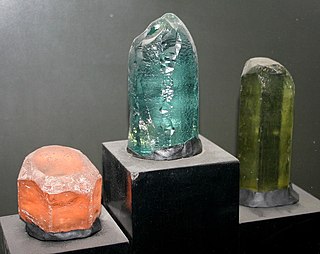
Beryl ( BERR-əl) is a mineral composed of beryllium aluminium silicate with the chemical formula Be3Al2Si6O18. Well-known varieties of beryl include emerald and aquamarine. Naturally occurring hexagonal crystals of beryl can be up to several meters in size, but terminated crystals are relatively rare. Pure beryl is colorless, but it is frequently tinted by impurities; possible colors are green, blue, yellow, pink, and red (the rarest). It is an ore source of beryllium.
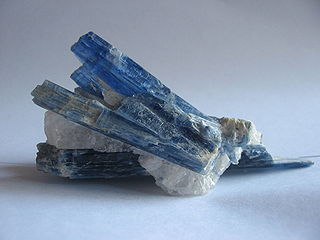
Kyanite is a typically blue aluminosilicate mineral, found in aluminium-rich metamorphic pegmatites and sedimentary rock. It is the high pressure polymorph of andalusite and sillimanite, and the presence of kyanite in metamorphic rocks generally indicates metamorphism deep in the Earth's crust. Kyanite is also known as disthene or cyanite.
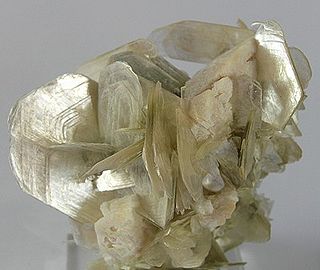
Muscovite (also known as common mica, isinglass, or potash mica) is a hydrated phyllosilicate mineral of aluminium and potassium with formula KAl2(AlSi3O10)(F,OH)2, or (KF)2(Al2O3)3(SiO2)6(H2O). It has a highly perfect basal cleavage yielding remarkably thin laminae (sheets) which are often highly elastic. Sheets of muscovite 5 meters × 3 meters (16.5 feet × 10 feet) have been found in Nellore, India.

A pegmatite is an igneous rock showing a very coarse texture, with large interlocking crystals usually greater in size than 1 cm (0.4 in) and sometimes greater than 1 meter (3 ft). Most pegmatites are composed of quartz, feldspar, and mica, having a similar silicic composition to granite. However, rarer intermediate composition and mafic pegmatites are known.

Microcline (KAlSi3O8) is an important igneous rock-forming tectosilicate mineral. It is a potassium-rich alkali feldspar. Microcline typically contains minor amounts of sodium. It is common in granite and pegmatites. Microcline forms during slow cooling of orthoclase; it is more stable at lower temperatures than orthoclase. Sanidine is a polymorph of alkali feldspar stable at yet higher temperature. Microcline may be clear, white, pale-yellow, brick-red, or green; it is generally characterized by cross-hatch twinning that forms as a result of the transformation of monoclinic orthoclase into triclinic microcline.

Pezzottaite, marketed under the name raspberyl or raspberry beryl, is a mineral species first recognized by the International Mineralogical Association in September 2003. Pezzottaite is a caesium analogue of beryl, a silicate of caesium, beryllium, lithium and aluminium, with the chemical formula Cs(Be2Li)Al2Si6O18. Named after Italian geologist and mineralogist Federico Pezzotta, pezzottaite was first thought to be either red beryl or a new variety of beryl ("caesium beryl"); unlike actual beryl, however, pezzottaite contains lithium and crystallizes in the trigonal crystal system rather than the hexagonal system.
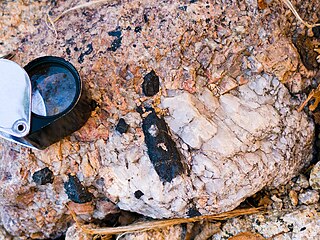
Riebeckite is a sodium-rich member of the amphibole group of silicate minerals, chemical formula Na2(Fe2+3Fe3+2)Si8O22(OH)2. It forms a solid solution series with magnesioriebeckite. It crystallizes in the monoclinic system, usually as long prismatic crystals showing a diamond-shaped cross section, but also in fibrous, bladed, acicular, columnar, and radiating forms. Its Mohs hardness is 5.0–6.0, and its specific gravity is 3.0–3.4. Cleavage is perfect, two directions in the shape of a diamond; fracture is uneven, splintery. It is often translucent to nearly opaque.
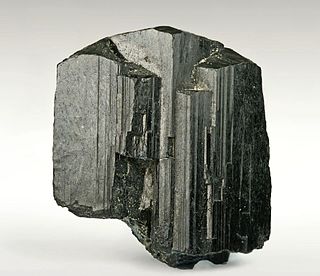
Arfvedsonite is a sodium amphibole mineral with composition: [Na][Na2][(Fe2+)4Fe3+][(OH)2|Si8O22]. It crystallizes in the monoclinic prismatic crystal system and typically occurs as greenish black to bluish grey fibrous to radiating or stellate prisms.
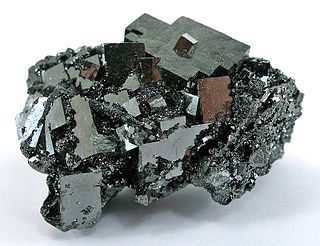
Bixbyite is a manganese iron oxide mineral with chemical formula: (Mn,Fe)2O3. The iron/manganese ratio is quite variable and many specimens have almost no iron. It is a metallic dark black with a Mohs hardness of 6.0 – 6.5. It is a somewhat rare mineral sought after by collectors as it typically forms euhedral isometric crystals exhibiting various cubes, octahedra, and dodecahedra.

Babingtonite is a calcium iron manganese inosilicate mineral with the formula Ca2(Fe,Mn)FeSi5O14(OH). It is unusual in that iron(III) completely replaces the aluminium so typical of silicate minerals. It is a very dark green to black translucent mineral crystallizing in the triclinic system with typically radial short prismatic clusters and druzy coatings. It occurs with zeolite minerals in cavities in volcanic rocks. Babingtonite contains both iron(II) and iron(III) and shows weak magnetism. It has a Mohs hardness of 5.5 to 6 and a specific gravity of 3.3.
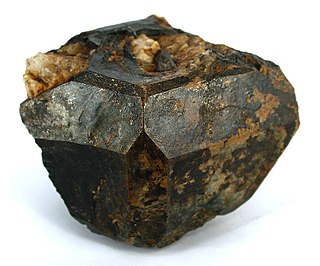
Microlite was once known as a pale-yellow, reddish-brown, or black isometric mineral composed of sodium calcium tantalum oxide with a small amount of fluorine. Its chemical formula is(Na,Ca)2Ta2O6(O,OH,F). Today it is a name of a group of oxide minerals of a similar stoichiometry having tantalum prevailing over titanium and niobium. The microlite group belongs to a large pyrochlore supergroup that occurs in pegmatites and constitutes an ore of tantalum. It has a Mohs hardness of 5.5 and a variable specific gravity of 4.2 to 6.4. It occurs as disseminated microscopic subtranslucent to opaque octahedral crystals with a refractive index of 2.0 to 2.2. Microlite is also called djalmaite, but both names are now obsolete.

Lorenzenite is a rare sodium titanium silicate mineral with the formula Na2Ti2Si2O9 It is an orthorhombic mineral, variously found as colorless, grey, pinkish, or brown crystals.

Sabinaite (Na4Zr2TiO4(CO3)4) is a rare carbonate mineral. It crystallizes in the monoclinic crystal system as colorless to white prisms within cavities. It is more typically found as powdery coatings and masses. It has a specific gravity of 3.36.

Baotite Ba4Ti4(Ti, Nb, Fe)4(Si4O12)O16Cl is a rare mineral recognized as having a unique four-fold silicate ring. Crystals are tetragonal, though commonly deformed to the extent of appearing monoclinic. Named for the locality of first discovery, Baotou, China, baotite has been found in hydrothermal veins and alkalic rocks in various locations around the world.

Tienshanite, named for the Tian Shan Range in Mongolia, is a rare borosilicate mineral, though rock-forming in some parts of its original locality at the Dara-i-Pioz Glacier in Tajikistan. Its formula is extremely complex: KNa3(Na,K,[])6(Ca,Y,RE)2Ba6(Mn2+,Fe2+,Zn,Ti)6(Ti,Nb)6Si36B12O114[O5.5(OH,F)3.5]F2.

Dollaseite-(Ce) is a sorosilicate end-member epidote rare-earth mineral which was discovered by Per Geijer (1927) in the Ostanmossa mine, Norberg district, Sweden. Dollaseite-(Ce), although not very well known, is part of a broad epidote group of minerals which are primarily silicates, the most abundant type of minerals on earth. Dollaseite-(Ce) forms as dark-brown subhedral crystals primarily in Swedish mines. With the ideal chemical formula, CaREE3+
Mg
2AlSi
3O
11,(OH)F, dollaseite-(Ce) can be partially identified by its content of the rare earth element cerium.
Bityite is considered a rare mineral, and it is an endmember to the margarite mica sub-group found within the phyllosilicate group. The mineral was first described by Antoine François Alfred Lacroix in 1908, and later its chemical composition was concluded by Professor Hugo Strunz. Bityite has a close association with beryl, and it generally crystallizes in pseudomorphs after it, or in cavities associated with reformed beryl crystals. The mineral is considered a late-stage constituent in lithium bearing pegmatites, and has only been encountered in a few localities throughout the world. The mineral was named by Lacroix after Mt. Bity, Madagascar from where it was first discovered.

Simpsonite has a general formula of Al4(Ta,Nb)3O13(OH). It occurs as euhedral to subhedral tabular to short and prismatic crystals, commonly in subparallel groups. Under the petrographic microscope it has a very high relief.
Carbokentbrooksite is a very rare mineral of the eudialyte group, with formula (Na,□)12(Na,Ce)3Ca6Mn3Zr3NbSiO(Si9O27)2(Si3O9)2(OH)3(CO3).H2O. The original formula was extended to show the presence of cyclic silicate groups and silicon at the M4 site, according to the nomenclature of eudialyte group. Carbokenbrooksite characterizes in being carbonate-rich (the other eudialyte-group species with essential carbonate are zirsilite-(Ce), golyshevite, and mogovidite). It is also sodium rich, being sodium equivalent of zirsilite-(Ce), with which it is intimately associated.

Zirsilite-(Ce) is a very rare mineral of the eudialyte group, with formula (Na,□)12(Ce,Na)3Ca6Mn3Zr3NbSi(Si9O27)2(Si3O9)2O(OH)3(CO3)·H2O. The original formula was extended to show the presence of cyclic silicate groups and the presence of silicon at the M4 site, according to the nomenclature of the eudialyte group. Zirsilite-(Ce) differs from carbokentbrooksite in cerium-dominance over sodium only. Both minerals are intimately associated. The only other currently known representative of the eudialyte group having rare earth elements (in particular cerium, as suggested by the "-Ce)" Levinson suffix in the name) in dominance is johnsenite-(Ce).


















